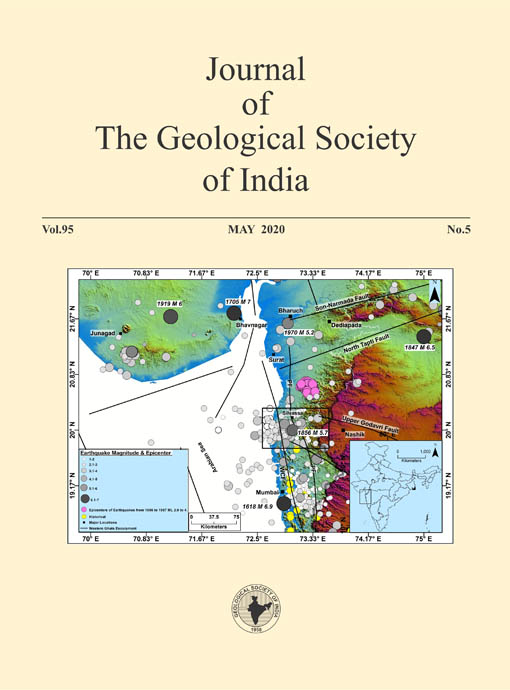Evaluation of Geochemical Characteristics of Groundwater in Parts of Ghataprabha Sub-basin Using DRASTIC Indices
DOI:
https://doi.org/10.1007/s12594-020-1470-8Keywords:
No Keywords.Abstract
Ghataprabha is an auxiliary of river Krishna and flows over Chandgad taluk of Kolhapur district, Maharashtra. Bauxite mining was one of the major issues in this part of the sub-basin, in the early '90s due to which there was a strong public protest about the quality of water. Accordingly, a survey was conducted to get the public perception on water pollution in the headwater catchment of Ghataprabha sub-basin. During the survey, a broad opinion was expressed with regard to water quality contamination of Ghataprabha river by a section of the society living in the riparian zones of the river basin. Therefore, in this paper, an effort has been done to understand the in variation in water quality with special reference to groundwater. Thirty-eight groundwater samples (nineteen each from before and after rainy season) were assembled and analysed for EC, TDS, pH, chlorine ion HCO3, SO4, PO4, Ca, Mg, Na and K. The values have shown that the density of all measured factors is broadly within the permissible limits (as per BIS Standards), before and after-monsoon. The present observations do compared with the earlier reported parameters of the year 2000. The results show that there is a betterment of water quality in the mining field as compared to previous data. This clearly demonstrates that the mining area can be reclaimed over the years by taking appropriate conservation measures. However, ionic ratios such as SAR, KR and SSP showed considerable variations indicating that there is localised impact on water quality resulting in the groundwater pollution. DRASTIC indices were computed based on hydrogeological characteristics and found that more than 30% of the observatory wells are contaminated where the nitrates are very high (more than 45mg/L) which clearly demonstrated that groundwater is getting polluted in high intense agriculture areas and also in areas close to settlements.Downloads
Metrics
Issue
Section
Downloads
Published
How to Cite
References
APHA (2000) Standard methods for examination of water and wastewater 20th Ed. American Publ. Health Assoc., Washington D.C.
Aller, L. Bennett, T. Lehr, J.H. Petty, R.J. Hackett, G. (1987) DRASTIC: A Standardized System for Evaluating Groundwater Potential Using Hydrogeologic Settings; EPA/600/2-85/018; U.S. Environmental Protection Agency: Washington, DC, USA,
BIS (1998) Bureau of Indian Standards IS: 10500, Manak Bhavan, New Delhi, India
Central Ground Water Board. Groundwater (2009) Information Booklet, Belgaum, District, Karnataka.
Lobo - Ferreira, J.P., Chachadi, A.G., Manuel, M., Oliveira Kai Nagel and Raikar, P.S. (2003) Ground water vulnerability assessment of the Goa case study area. Coastal Tourism, Environment, and Sustainable Local Development, pp.166-178.
Holden, L.R., Graham, J.A., Whitmore, R.W., Alexander, W.J., Pratt, R.W., Liddle, S.F. and Piper, L.L. (1992) Results of the national alachlor well water survey. Environ. Sci. Technol., v.26, pp.936-943.
Kaliraj, S., Chandrasekar, N., Simon Peter, T., Selvakumar, S. and Magesh, N.S. (2015), Mapping of coastal aquifer vulnerable zone in the south west coast of Kanyakumari, South India, using GIS-based DRASTIC model; Environ. Monit. Assess., v.187, pp.4073.
Kelly, W.P. (1963) Use of saline irrigation water. Soil Science, v.95, pp.385-391.
Maas, R.P., Kucken, D.J., Patch, S.C., Peek, B.T. andVan Engelen, D.L., (1995) Pesticides in eastern North Caroline rural supply wells: Land use factors and persistence. Jour. Environ. Quality, v.24, pp.426-431.
Piper, A.M. (1953) A graphic procedure I the geo-chemical interpretation of water analysis. USGS Groundwater Note no 1, 12.
Prasad, R.K., Singh,V.S., Krishnamacharyulu, S.K. and Banerjee P. (2011) Application of DRASTIC model and GIS: For assessing vulnerability in hard rock granitic aquifer. Environ. Monitor. Assess., v.176, pp.143-155.
Purandara, B.K., Varadarajan, N., Venkatesh, B. and Choubey, K. (2012) Surface water quality evaluation and modeling of Ghataprabha River, Karnataka, India. Environ. Monit. Assess., v.184(3) pp.1371-1378.
Sawyer, C., McCarty, P. and Parkin, G. (2003) Chemistry for Environmental Engineering and Science
Shirazi, S.M., Imran, H.M., Akib, S., Yusop, Z., Harun, Z.B. (2013), Ground water vulnerability assessment in the Melaka State of Malaysia using DRASTIC and GIS techniques. Environ. Earth Sci., v.70, pp.2293-2304.

 Shailaja. C. Mali
Shailaja. C. Mali






